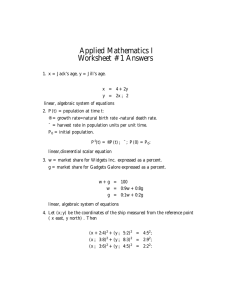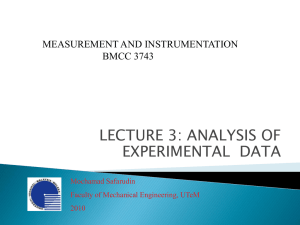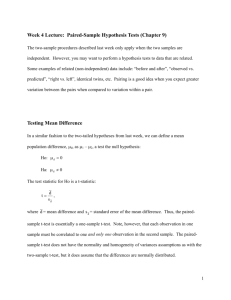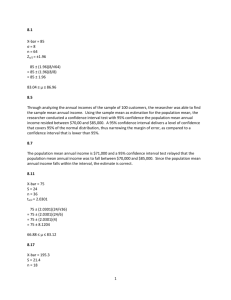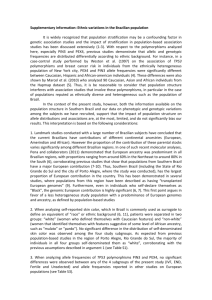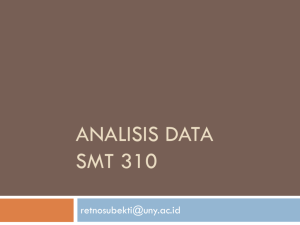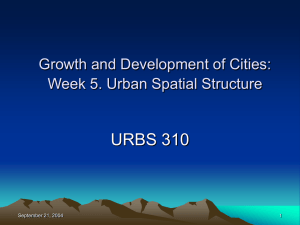Modeling Middle Urban Population Density With Remote Sensing Imagery Lu An-min
advertisement
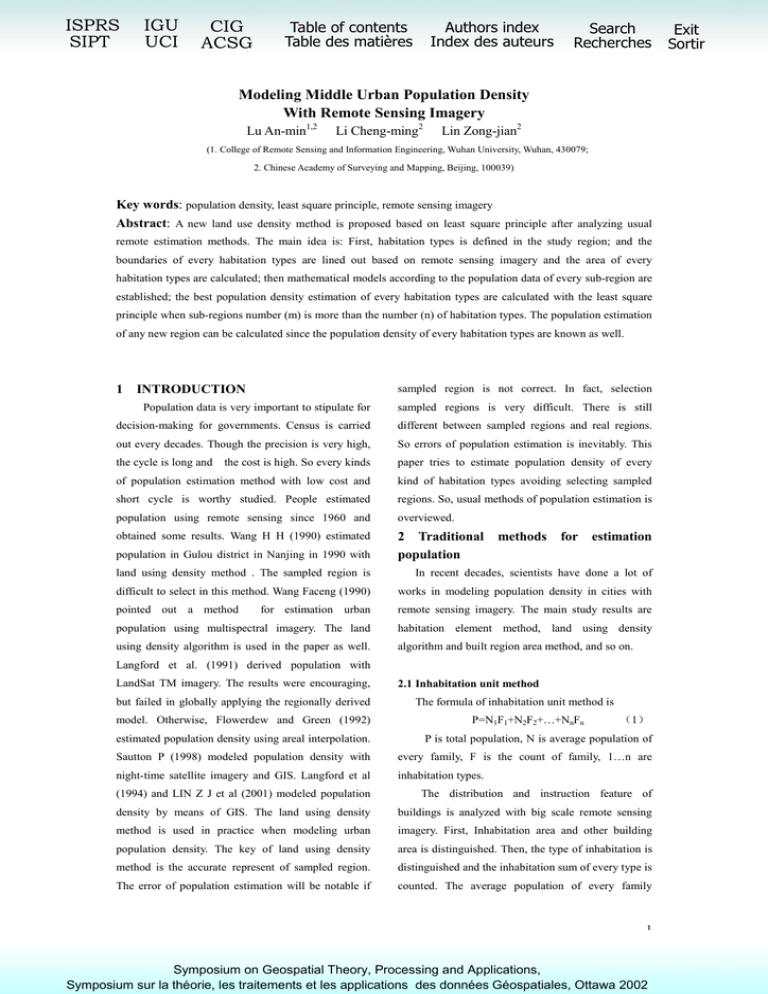
ISPRS SIPT IGU UCI CIG ACSG Table of contents Table des matières Authors index Index des auteurs Search Recherches Modeling Middle Urban Population Density With Remote Sensing Imagery Lu An-min1,2 Li Cheng-ming2 Lin Zong-jian2 (1. College of Remote Sensing and Information Engineering, Wuhan University, Wuhan, 430079; 2. Chinese Academy of Surveying and Mapping, Beijing, 100039) Key words: population density, least square principle, remote sensing imagery Abstract: A new land use density method is proposed based on least square principle after analyzing usual remote estimation methods. The main idea is: First, habitation types is defined in the study region; and the boundaries of every habitation types are lined out based on remote sensing imagery and the area of every habitation types are calculated; then mathematical models according to the population data of every sub-region are established; the best population density estimation of every habitation types are calculated with the least square principle when sub-regions number (m) is more than the number (n) of habitation types. The population estimation of any new region can be calculated since the population density of every habitation types are known as well. 1 INTRODUCTION sampled region is not correct. In fact, selection Population data is very important to stipulate for sampled regions is very difficult. There is still decision-making for governments. Census is carried different between sampled regions and real regions. out every decades. Though the precision is very high, So errors of population estimation is inevitably. This the cycle is long and the cost is high. So every kinds paper tries to estimate population density of every of population estimation method with low cost and kind of habitation types avoiding selecting sampled short cycle is worthy studied. People estimated regions. So, usual methods of population estimation is population using remote sensing since 1960 and overviewed. obtained some results. Wang H H (1990) estimated 2 Traditional population population in Gulou district in Nanjing in 1990 with methods for estimation land using density method . The sampled region is In recent decades, scientists have done a lot of difficult to select in this method. Wang Faceng (1990) works in modeling population density in cities with pointed out a method for estimation urban remote sensing imagery. The main study results are population using multispectral imagery. The land habitation element method, land using density using density algorithm is used in the paper as well. algorithm and built region area method, and so on. Langford et al. (1991) derived population with LandSat TM imagery. The results were encouraging, but failed in globally applying the regionally derived model. Otherwise, Flowerdew and Green (1992) 2.1 Inhabitation unit method The formula of inhabitation unit method is P=N1F1+N2F2+…+NnFn (1) estimated population density using areal interpolation. P is total population, N is average population of Sautton P (1998) modeled population density with every family, F is the count of family, 1…n are night-time satellite imagery and GIS. Langford et al inhabitation types. (1994) and LIN Z J et al (2001) modeled population The distribution and instruction feature of density by means of GIS. The land using density buildings is analyzed with big scale remote sensing method is used in practice when modeling urban imagery. First, Inhabitation area and other building population density. The key of land using density area is distinguished. Then, the type of inhabitation is method is the accurate represent of sampled region. distinguished and the inhabitation sum of every type is The error of population estimation will be notable if counted. The average population of every family 1 Symposium on Geospatial Theory, Processing and Applications, Symposium sur la théorie, les traitements et les applications des données Géospatiales, Ottawa 2002 Exit Sortir obtained from sample. This method is fit for big scale region is Pj. There are i kinds of habitation types, remote i=1,2…n. The population density of every habitation sensing imagery and the precise of inhabitation count is 99%. The inhabitation is disperse type is Di, then in county. It is easy to count the inhabitation. So this Pj = method is fit for county. n ∑ ( A ji D i ) (3) i =1 the quantity of (3) is P1=A11D1+ A12D2+...+ A1nDn 2.2 Land use density method In city, the population density is different from P2=A21D1+ A22D2+...+A2nDn with every kind of land use types. The relation of population and land use type is Pm=Am1D1+Am2D2+...+ AmnDn n P = ∑ ( Ai Di ) i =1 the matrix of (3) is (2) P=AD A1、A2…An are the area of every land use type. D1、 D2…Dn are the population density of every land use type, P is total population. The land use type is obtained from the different of population density. The flow of this method is: first, the inhabitation and the non-inhabitation is distinguished with remote sensing imagery. Every kind of inhabitation type is distinguished in inhabitation area. The boundary of every kind of inhabitation is draw out. Then, the area of every kind of inhabitation is measured. The area of every kind of inhabitation type multiplying P1 P 2 P= ... Pm (4) a11 a12 ...a1n a a ... a A = 21 22 2n ... a m1 a m2 ...a mn D1 D 2 D= ... Dn When m>n, that is, the region count known corresponding population is more than habitation type count. The population density from sample is the estimation least square principle is used to calculate the best population of every kind of inhabitation type. The population density estimation of every kind of total sum of every kind of inhabitation type is the total habitation which the errors of statistical population is population in study area. least. D=[ATA]-1ATP 3 Land use density method based on least square principle (5) General speaking, the more that m being bigger than n, the more the quality of population density The excellence of the land use density method is estimation. The population estimation of any region it’s idea and calculation is simple; the disadvantage of can be calculated since the population density of every the method is that the selection of sampled region is habitation types are known as well. much more difficult. Is there a method the population density of every habitation type is estimated but the sampled region need not be selected. In some region, there is mathematical relation among the area, the population density and it’s total population of every habitation type. The population density of every habitation type can be estimated via the mathematical relations. Suppose there are j regions which the population is known, j=1,2…m. The population sum of every 2 4 Experiment and analysis imagery(1995). There are 6 region which their population 4.1 Habitation types and their area There are 4 kinds of habitations in the study region: high building, multilayer building, simple building and compositive building. The high building indicates a building with more than 7 layers. The multilayer building indicates a building with from 3 to 6 layers. The simple building indicate a building with less than 3 layers. The compositive building indicate a building which used for business and habitation. First, habitation region is distinguished from other types. Every kind of habitation is distinguished in habitation region(Fig.1). Then, the boundary of known including fengsheglu, daguanzhuang, xihoujie, beidajie, ronghejie and lingyuanxi, etc. The every kind of habitation is drawn out and the area of every kind of habitation is measured(Tab.1) experiment data include 1:10000 remote sensing Fig.1 study region and its habitation types Tab.1 The area and estimation population density region Fengsheglu Total area (k m2) 0.09384 Daguan zhuang 0.31318 xihoujie 0.21977 beidajie 0.23179 yonghejie 0.15311 lingyuanxi 0.21567 total 1.22736 Habitation type Area (k m2) multilayer building simple building high building multilayer building simple building compositive building multilayer building simple building compositive building high building compositive building high building multilayer building compositive building multilayer building compositive building 0.06945 0.02439 0.02663 0.04028 0.09269 0.15358 0.07363 0.03141 0.11473 0.04578 0.18601 0.0329 0.02792 0.09229 0.03282 0.18285 4.2 Models calculation and error analysis There are 4 kinds of habitation types and 6 Estimation density (person/km2) 14810 4394 49014 14810 4394 1784 14810 4394 1784 49014 1784 49014 14810 1784 14810 1784 Estimation population total Statistical population Relatively error(%) 1028 107 1305 596 407 274 1090 138 205 2243 331 1612 413 165 486 326 1135 1192 -4.7 2582 2173 18 1432 1572 -8.9 2574 2621 -1.7 2190 2260 -3 812 889 -8.6 10725 10707 -0.1 building, multilayer building, simple building and compositive building in fenshenglu region, etc(Tab.1). There is 6 equations and 4 unknown. The best sub-region with known population. 6 equations can be population density estimation of every habitation listed from formula (3) P1=A11D1+A12D2+A13D3+A14D4 types are calculated with the least square P2=A21D1+A22D2+A23D3+A24D4 principle(Tab.1). The precise of population estimation … can be calculated using formula 3(Tab.1). P6=A61D1+A62D2+A63D3+A64D4 Population of any other new region can be P1…P6 indicate the statistical population. D1、D2、 calculated since the population density of every kind D3、D4 indicate the population density of high building, of habitation type is known. The experiment result is multilayer building, simple building and compositive shown in table 2. building, respectively. Indicate the area of high Tab. 2 population estimation of new unknown region 3 region Total area (k m2) 0.30611 qiliyan dongshun jie 0.31078 jianshelu 0.2509 5 Habitation type Area (k m2) high building multilayer building simple building compositive building multilayer building simple building compositive building high building compositive building 0.03364 0.05426 0.04273 0.17548 0.14124 0.02431 0.14523 0.05738 0.19352 Estimation density (person/km2) 49014 14810 4394 1784 14810 4394 1784 49014 1784 CONCLUTION Estimation population total Statistical population Relatively error(%) 1648 803 187 313 2091 106 259 2812 345 2951 2773 -6.4 2456 2572 4.5 3157 2896 -9.0 Areal Interpolation Methods and GIS[J]. Annals of Regional Science. 1992(26), 67-78. This paper pointed out a new land using density method based on least square principle. The method [4] Sutton P. Modeling Population Density with need not sample the population density of every Night-time Satellite Imagery and GIS[J]. habitation Comput., Environ. and Urban Systems, 1997, types. The estimation workload of 21(3/4): 227-244. population density of every habitation type is low. The mathematical models is not influenced by random [6] Langford M.and Unwin D J. Generating and Mapping Population Density Surfaces within a error of sample. The main idea is: (1) habitation types is defined in the study region; (2) the boundaries of Geographical every habitation types are lined out based on remote Cartographic Journal. 1994(31), 21-26. sensing imagery and the area of every habitation types [7] Information System. The Lin Zongjian, Jin Yimin and Li Chengming. are calculated; (3) mathematical models according to Urban Population Geographical Information the System[A]. population data of every sub-region are The 20th international established; (4)the best population density estimation cartographic conference[C], Beijing, 2001, of every habitation types are calculated with the least 1279-1282. square principle when sub-regions number (m) is [8] Ogrosky C E. Population Estimates from more than the number (n) of habitation types. (5)The Satellite Imagery[J]. Photogrammetric population estimation of any region can be calculated Engineering and Remote Sensing, 1975(41), since the population density of every habitation types 707-712. are known as well. References [1] Wang H H. City Population Estimation Method with Satellite Imagery[J]. Remote Sensing Technology .1990(3):48-54. [2] Wang F Z. Urban Population Estimation—Multispectral Imagery Analysis[J]. Urban Environment and Urban Ecology. 1990, 3(3): 42-34. [3] Langford M, Maguire D J, & Unwin D J. The Areal Interpolation Problem: Estimating Population Using Remote Sensing in a GIS Framework[A]. In Masser I & Blakemore M. (Eds.), Handling Geographical Information [C],55-77. London: Longman, 1991. [3] Flowerdew R and Green M. Developments in 4
